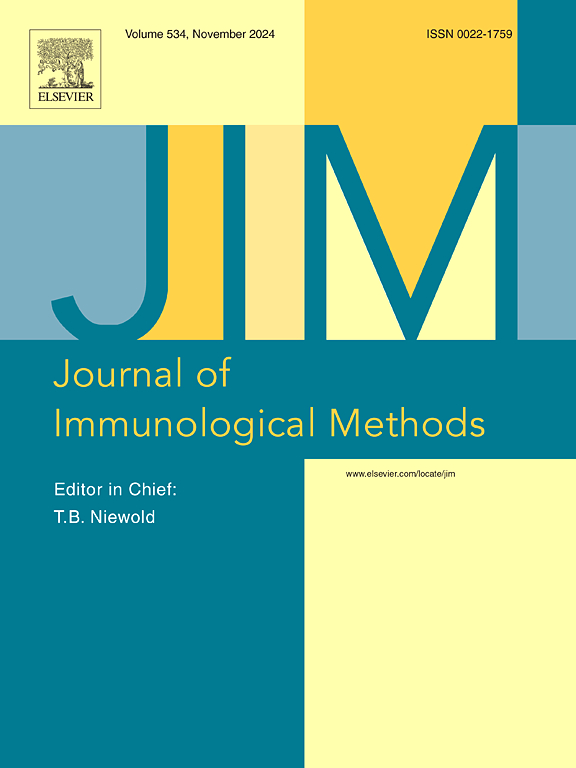在Phadia平台上开发一种新型全自动高通量GAD65自身抗体检测方法并进行性能评估。
IF 1.6
4区 医学
Q4 BIOCHEMICAL RESEARCH METHODS
引用次数: 0
摘要
目的:在临床上,糖尿病是通过血糖水平或糖化血红蛋白(HbA1c)来确定的。然而,为了区分1型和2型糖尿病(T1D和T2D)以获得适当的治疗,患者在第二级检测1型糖尿病相关自身抗体的存在。抗gad65自身抗体是儿童和成人T1D患者T1D的主要标志物之一。如果检测到抗gad65自身抗体,则患者为1型糖尿病,需要胰岛素治疗。在1型糖尿病的临床常规诊断中,gad65血清学是使用一种称为桥接ELISA的特殊检测结构进行的。将这些检测方法应用于自动化ELISA系统是一个持续的挑战,因此它们很难应用于常规临床实验室的高通量检测。方法:我们基于Phadia仪器平台上的桥接免疫分析格式,开发了第一个全自动、高通量GAD65自身抗体荧光酶免疫分析,称为EliA GAD65,并将其性能与RSR™的桥接ELISA (GADAb ELISA)和Snibe Diagnostics的全自动MAGLUMI®GAD65化学发光分析(CLIA)进行了比较。结果:EliA GAD65的ROC分析显示,与GADAb ELISA的曲线下面积(AUC) 0.923(95 % CI 0.884 ~ 0.963)相比,EliA GAD65的曲线下面积(AUC)为0.906(95 % CI 0.864 ~ 0.949),两种方法之间无显著差异(p = 0.384)。调整后的特异性96 %,伊利亚GAD65显示76 %的灵敏度(CI 95 % 66.4 % 84.0 %)敏感性的74年相比 %(95 %可信区间64.6 % 81.6 %)GADAb ELISA。当全自动MAGLUMI®GAD65 CLIA与GADAb ELISA进行比较时,它显示出92.9 %(95 % CI 86.6 %至96.4 %)的总一致性,较少阳性样品的检测,而EliA GAD65与GADAb ELISA的总一致性为100 %(95 % CI 96.7 %至100 %)。结论:全自动EliA GAD65检测显示与已建立的桥接GADAb ELISA相似的临床特征,与全自动MAGLUMI®GAD65 CLIA相比,与GADAb ELISA的一致性更高。本文章由计算机程序翻译,如有差异,请以英文原文为准。
Development and performance evaluation of a novel, fully automated, high-throughput GAD65 autoantibody assay on the Phadia platform
Objectives
In clinics, diabetes is determined by blood glucose levels or by glycosylated hemoglobin (HbA1c). However, to distinguish between Type 1 and Type 2 diabetes (T1D and T2D) for adequate treatment, patients are tested for the presence of Type 1 diabetes-relevant autoantibodies in the second tier.
Anti-GAD65 autoantibody is one of the main markers for T1D in both pediatric and adult T1D patients. If the anti-GAD65 autoantibody is detectable, the patients have type 1 diabetes and need to be treated with insulin.
In the clinical routine diagnostics of type 1 diabetes, GAD65-serology is performed using a special assay architecture known as bridging ELISA. Adapting these assays onto automated ELISA systems has shown to be a constant challenge, so they can be hardly applied for high throughput testing in a routine clinical laboratory.
Methods
We developed the first fully automated, high-throughput GAD65 autoantibody fluorescence enzyme immunoassay based on the bridging immunoassay format on Phadia instrument platform, termed EliA GAD65 and compared its performance with the bridging ELISA from RSR™ (GADAb ELISA) and the fully automated MAGLUMI® GAD65 chemiluminescence assay (CLIA) from Snibe Diagnostics.
Results
When tested for clinical performance, ROC Analysis of EliA GAD65 showed an Area under the curve (AUC) of 0.906 (95 % CI 0.864 to 0.949) compared to the AUC of 0.923 (95 % CI 0.884to 0.963) of GADAb ELISA with no significant difference between the two assays (p = 0.384). When adjusted to a specificity of 96 %, EliA GAD65 showed a sensitivity of 76 % (CI 95 % 66.4 % to 84.0 %) compared to a sensitivity of 74 % (95 % CI 64.6 % to 81.6 %) of GADAb ELISA. When the fully automated MAGLUMI® GAD65 CLIA was compared to GADAb ELISA, it showed a total agreement of 92.9 % (95 % CI 86.6 % to 96.4 %) with less positive samples detected in contrast to the total agreement of 100 % (95 % CI 96.7 % to 100 %) of EliA GAD65 to GADAb ELISA.
Conclusions
Fully automated EliA GAD65 assay displays similar clinical characteristics as the well-established bridging GADAb ELISA and a higher agreement with the GADAb ELISA than the automated MAGLUMI® GAD65 CLIA.
求助全文
通过发布文献求助,成功后即可免费获取论文全文。
去求助
来源期刊
CiteScore
4.10
自引率
0.00%
发文量
120
审稿时长
3 months
期刊介绍:
The Journal of Immunological Methods is devoted to covering techniques for: (1) Quantitating and detecting antibodies and/or antigens. (2) Purifying immunoglobulins, lymphokines and other molecules of the immune system. (3) Isolating antigens and other substances important in immunological processes. (4) Labelling antigens and antibodies. (5) Localizing antigens and/or antibodies in tissues and cells. (6) Detecting, and fractionating immunocompetent cells. (7) Assaying for cellular immunity. (8) Documenting cell-cell interactions. (9) Initiating immunity and unresponsiveness. (10) Transplanting tissues. (11) Studying items closely related to immunity such as complement, reticuloendothelial system and others. (12) Molecular techniques for studying immune cells and their receptors. (13) Imaging of the immune system. (14) Methods for production or their fragments in eukaryotic and prokaryotic cells.
In addition the journal will publish articles on novel methods for analysing the organization, structure and expression of genes for immunologically important molecules such as immunoglobulins, T cell receptors and accessory molecules involved in antigen recognition, processing and presentation. Submitted full length manuscripts should describe new methods of broad applicability to immunology and not simply the application of an established method to a particular substance - although papers describing such applications may be considered for publication as a short Technical Note. Review articles will also be published by the Journal of Immunological Methods. In general these manuscripts are by solicitation however anyone interested in submitting a review can contact the Reviews Editor and provide an outline of the proposed review.

 求助内容:
求助内容: 应助结果提醒方式:
应助结果提醒方式:


